

Melikgyugh, Armenia—Freshly home-baked gata (Armenian Puff Pastry Cake). I was lucky to arrive in this small village near Mount Aragats and be invited in by Tsayhlik on a day she was baking..
Most people in the Persian culinary region eat sweet treats as a break in the day, with tea or coffee, juice or water, rather than at the end of a meal. The sweet may be something baked, like a cookie or a pastry, but it could also be a spoonful of thick jam (see Apricot Moraba and Carrot Moraba in the fruit chapter) or a pudding. There are several Persian puddings here, smooth and creamy; they make elegant desserts.
Cookies and other sweetmeats are served at times of celebration—at Nou-Roz (New Year’s), for example, and at birthdays and weddings. Iran is famous for its cookies, each city or region having its own specialties. I’ve included the diamond-shaped cookies from the city of Yazd called baqlava (see recipe), which are drenched in sweet syrup, and several others that are Nou-Roz classics.
In Georgia and Armenia, home cooks work with layered pastry to make treats that are sometimes flavored with nuts and dried fruit and always rich with butter (see Armenian Puff Pastry Cake). The strudel-like rolled pastry called paghlava from Georgia (see recipe) is a distant cousin of the more familiar baklava of the eastern Mediterranean.
And finally there’s a Persian-style halvah from southern Iran, made not with sesame paste, as it is in Arab countries, but with toasted flour and butter flavored with sweet ripe dates.
Tea is the everyday drink, the lubricant of conversations in bazaars and at home, in Iran, Azerbaijan, and Kurdistan. Many Persian and Azeri households keep a large samovar, full of hot water, ready to wet the tea leaves in a pot or to dilute the strong brew already in the pot.
People in the region drink their tea without milk, sweetened with sugar. Sometimes it’s spiced with cardamom or a spice blend (see Tea from the Caspian and Spice Blend for Tea). Black tea is the standard in Iran and the rest of the region, but there is green tea too. In Georgia and Armenia, coffee made in the Armenian way (see recipe), an intense hit of sweet flavor and caffeine, is the more likely hot drink, though tea is always an option.
In warm weather, yogurt makes a favorite cold drink: Plain yogurt is mixed with cold water and ice, sprinkled with a little dried mint, perhaps, and lightly salted (see recipe). It’s very refreshing.
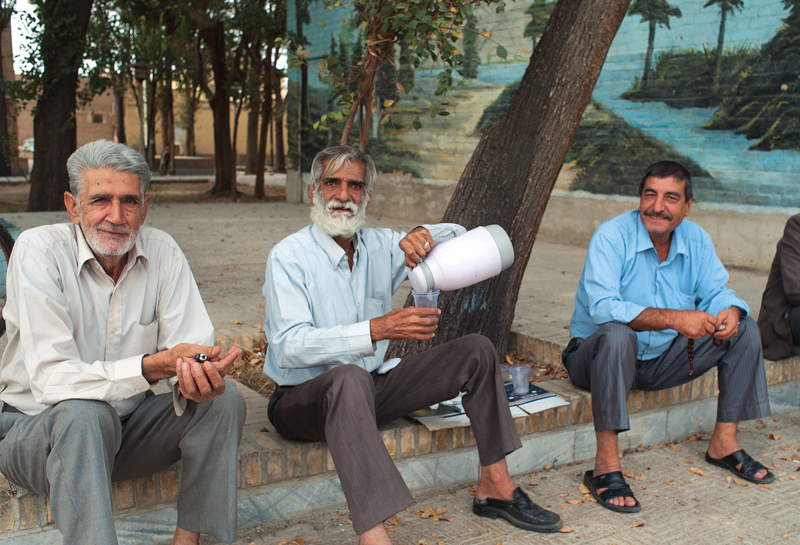
Yazd, Iran—There’s a painted mural on a wall at this little park in central Yazd, with palm trees offering some shade. A group of men sitting here chatting and drinking tea together invited me to join them.
This delectable pudding is smooth and creamy, lightly perfumed with rose water and topped with chopped pistachios. The pistachios are optional, but they complement the rose water beautifully.
Serves 6
2 cups whole milk
2 cups light cream
¼ cup rice flour
½ cup sugar
1 tablespoon rose water
About ½ cup shelled pistachios, ground to a coarse powder (optional)
Mix the milk and cream in a bowl. Pour ¼ cup of the mixture into another bowl.
Sift the rice flour into the smaller amount and whisk thoroughly to make a smooth paste. Slowly add another cup or so of the milk mixture, whisking so that there are no lumps. Transfer to a large heavy saucepan and add the remaining milk mixture, whisking to prevent lumps. Set over medium-low heat and stir in the sugar. Add the rose water and continue cooking, whisking often, until the mixture thickens, about 30 minutes. Taste and add a little more rose water if you like.
Pour into individual bowls or a large serving bowl. Set aside to cool a little, then cover and refrigerate for several hours or overnight to thicken. Serve chilled.
If you’d like to top the pudding with the ground pistachios, sprinkle them on just before serving, when the pudding has thickened.
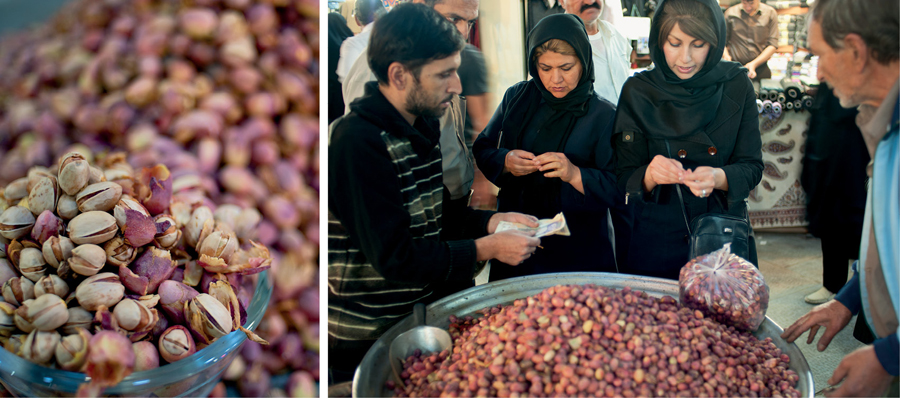
Isfahan, Iran—Pistachios close up, and women buying pistachios at the bazaar.
Rose water, cardamom, and pistachios play together enticingly in the creamy Persian version of rice pudding. Simple seduction.
Serves 6
¾ cup short-grain rice or broken rice (see Glossary)
4 cups whole milk
¾ cup sugar, or more to taste
3 tablespoons rose water, or more to taste
½ teaspoon ground cardamom
About 12 pistachios, coarsely chopped (optional)
Wash the rice well, place in a heavy pot with the milk, and bring to a boil. Lower the heat, partially cover, and simmer, stirring occasionally, until the rice softens and most of the liquid has been absorbed, about 1 hour. The pudding will have a soft, slightly soupy texture.
Stir in the sugar, rose water, and cardamom and cook, stirring, for 10 minutes. Taste and add a little more sugar or rose water if you wish. Let cool to room temperature.
If you like, top the pudding with the pistachios just before serving.
Left: Sheki, Azerbaijan—at the market, with barberries above, bright plump rose hips and garlic below.
Right: Kashan, Iran—stills for making rose water (for which Kashan is famous) and carpeted benches for customers to sit on while they sample the waters and sip tea.
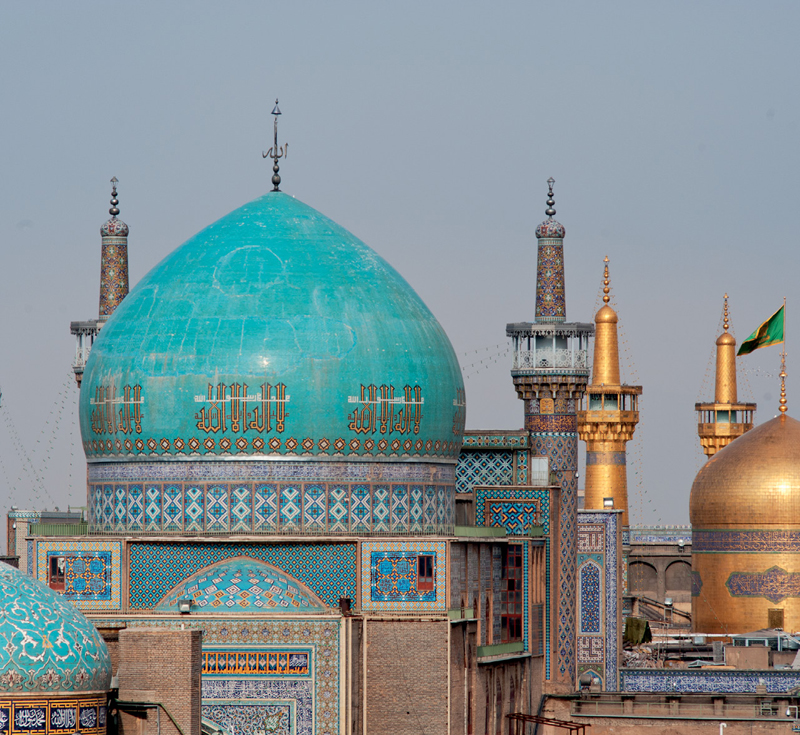
Mashad, Iran—The tomb of Imam Reza in far northeastern Iran is the holiest place in the country, a destination for about twenty million pilgrims annually. The huge complex consists of courtyards, mosques, and meeting places built around the tomb, which is marked by the golden dome.
When I visited the lovely shrine of Shah Chirag in Shiraz, a place of pilgrimage and one of the holiest sites in Iran, I picked up a flower-sprigged white chador from a bin of chadors, and draped it over my head so it covered me from head to toe. I clutched it closed at the front with one hand and passed through an archway into the graceful courtyard.
From there I went through the curtained women’s entrance into the mausoleum of Amir Ahmed. (He was the brother of Imam Reza, the much-revered seventh imam, whose shrine is in Mashad.)
Inside was a different world. A high mesh metal grille divides the men’s and women’s sections. The large white marble sarcophagus, protected by a metal grille, is set midway in the shrine so that it’s accessible from both the men’s and women’s sides. I walked forward past black-chadored women. Many sat on rugs on the ground praying, while others crowded around the sarcophagus, kissing the grillwork and touching it, some crying. Over the loudspeaker, a preacher was telling a story of the martyrdom of one of the imams, and as the story moved toward a tragic crescendo, many women burst out sobbing and rocked to and fro.
All this was happening in a place of light and beauty, with the black forms of the women reflected in fantastically complex mirrored tiling, a mosaic of triangles, squares, and diamond shapes that covered the walls and ceilings and gleamed and glinted in the light from glass chandeliers. The effect was dizzying, disorienting, and also thrilling in a way I can’t explain.
I sat down by a wall, letting the sounds and feelings wash over and through me. The echoing sound of the preacher’s hoarse voice lamenting, the women’s sobs and heartfelt anguish, and the thousands and thousands of mosaicked reflections that amplified sound and movement were like waves of human pain. I realized that I too felt the ache of grief and that I had become part of it all. Human pain and suffering, the hurts that we each experience in our lives, found expression and release in this outpouring of grief for the imams who died long ago and who are revered in Shia tradition.
I don’t know how long I sat there, feeling like a piece of flotsam being swept up by tides of emotion. Even as a nonbeliever, the experience of being in the shrine with all that intensity left me cleansed through.
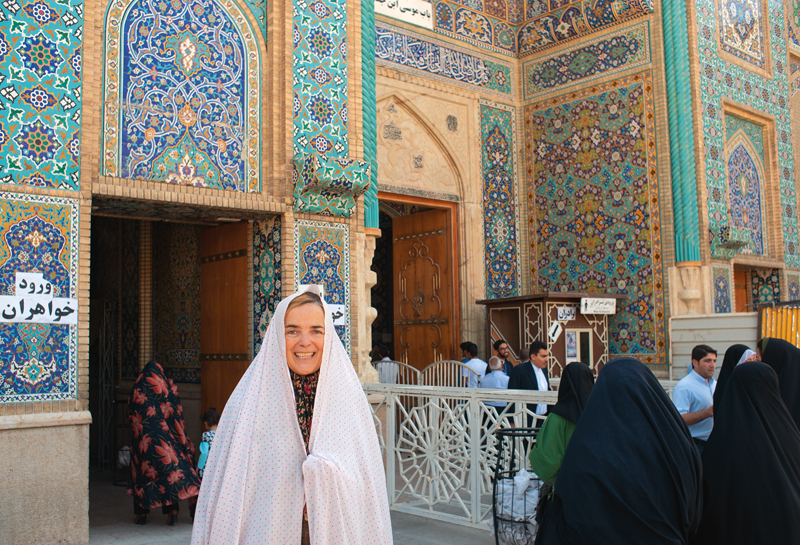
Shiraz, Iran—A fellow tourist took this photo of me outside the shrine of Shah Chirag, a beautiful mirrored place of worship and veneration. The shrine provides cotton chadors for women visitors; upon leaving, I just put my chador back into the bin.
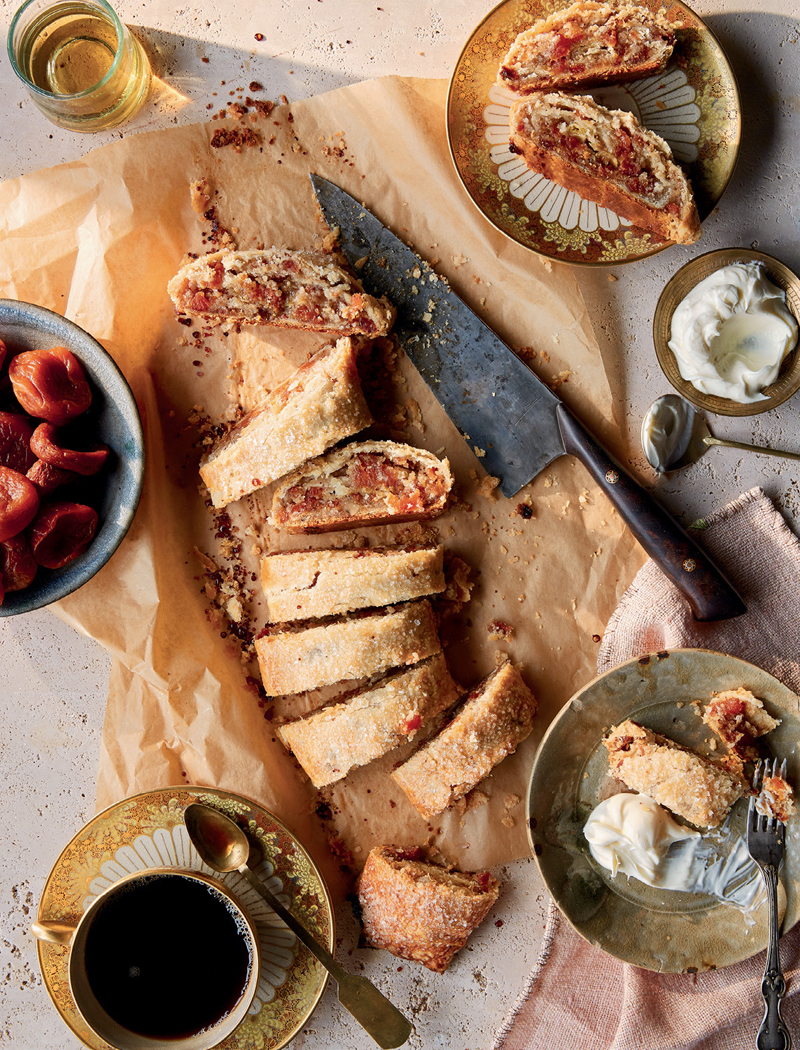
The baked pastry has been sliced after it cooled completely. Note that sulfured apricots will be bright-colored and attractive, as in these photos. But I prefer to use the duller brown unsulfured ones for their flavor. Chopped, partially cooked apple in place of half the apricots is also delicious.
The name of this terrific pastry from Georgia is paghlava, but it’s not the baklava of Turkey or Syria and Lebanon; it’s more like a cross between a strudel and baklava, with layers of pastry alternating with nuts and dried fruit. It’s a cousin of the Armenian puff pastry called gata (see recipe) and the Persian baqlava cookies from Yazd.
The pastry, freely adapted from a recipe in Julianne Margvelashvili’s book The Classic Cuisine of Soviet Georgia, is tender and easy to work with. It’s rolled out, covered with chopped dried apricots and walnuts, rolled up like a Persian rug and baked, then sliced once cooled.
This is especially delicious topped with heavy cream.
Serves 10
1¼ cups all-purpose flour, plus extra for surfaces
⅛ teaspoon baking soda
8 tablespoons (1 stick) very cold butter
⅓ to ½ cup sour cream, or substitute full-fat plain yogurt
1 to 2 teaspoons regular or pearl sugar for glazing
1 large egg, separated
¾ cup sugar
1 cup finely ground walnuts
1 cup chopped dried apricots (pieces about the size of small raisins)
¼ teaspoon ground cardamom
Place the flour and baking soda in a bowl and grate the butter into it. Rub the flour and butter together to make crumbs. Add ⅓ cup of the sour cream or yogurt and mix gently. Try to pull the pastry together; if it is too dry, add a little more sour cream or yogurt and mix to make a slightly soft dough.
Pull the pastry together into a ball and flatten into a thick disk. Seal in plastic and refrigerate until you are ready to use it.
Preheat the oven to 375°F. Line a baking sheet with parchment paper or grease it lightly.
Whisk the egg white in a medium bowl; set aside 1 teaspoon of the white. Add the sugar, walnuts, apricots, and cardamom to the remaining egg white and mix well. Set aside.
Place a cotton cloth on your work surface and dust it with flour. Flatten the pastry gently on the cloth. Use a rolling pin to roll it into a rectangle measuring about 15 by 20 inches, with one of the 15-inch sides nearest to you. Spread the filling on it, leaving a generous 1-inch border on the side farthest away from you and a ½-inch border on the other three sides. Beat the egg yolk and brush it onto the exposed pastry edges. Use the cloth to lift the edge of the pastry nearest you and roll it up like a jelly roll. Place seam side down on the lined baking sheet.
Brush the top of the pastry with the reserved egg white and sprinkle on a teaspoon or two of sugar. Bake for 20 to 25 minutes, or until well touched with gold. Let cool for at least 30 minutes before slicing.
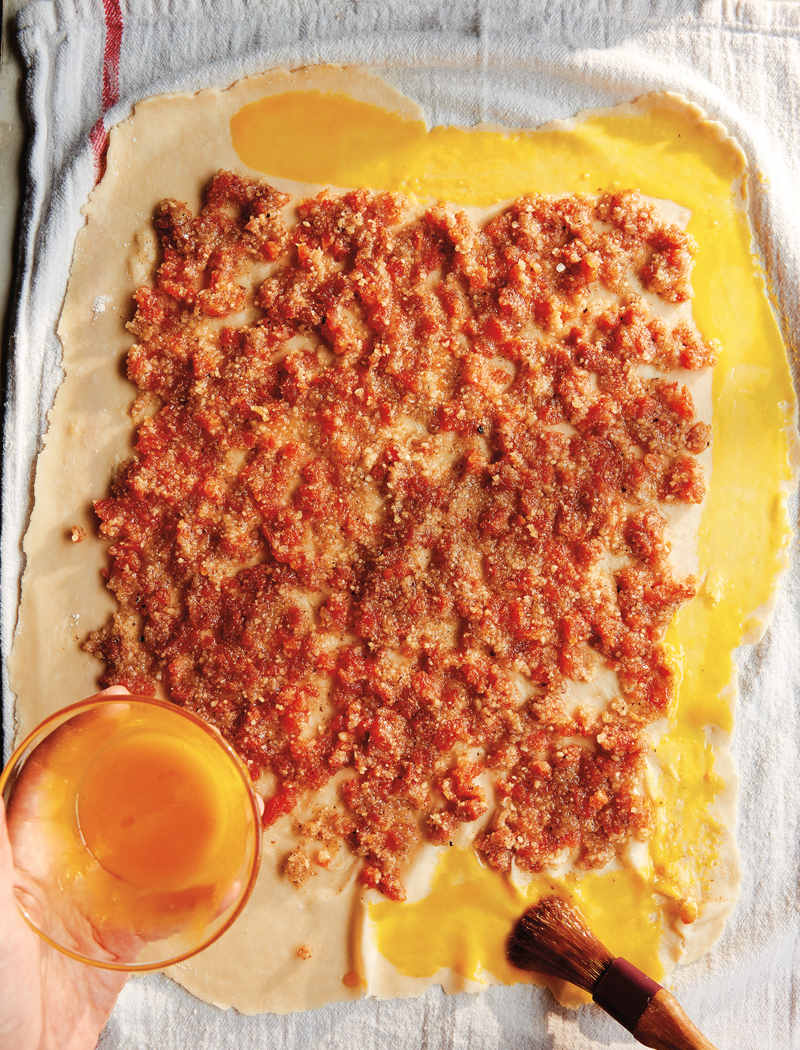
Rolled out and spread with the filling, the pastry is being brushed around the edges with egg yolk, which helps seal in the filling.
This pastry is an Armenian national treasure. Everyone has his or her favorite version. Gata is made with a dough similar to puff pastry that is filled with a lightly sweetened butter paste. I learned how to make gata from a hospitable, generous woman named Tsayhlik who lives with her family in a small high-altitude Armenian village below Mount Aragats.
Gata is often made as individual puff pastry rectangles. Tsayhlik made those and also gata in other shapes. This is the one I find easiest to make and serve: It’s a round of puff pastry with a buttery cardamom-scented filling. Serve it cut into wedges.
Makes 2 large filled pastries; each serves 8
2 medium or large egg yolks
1 cup lukewarm water
1 tablespoon cider vinegar or white wine vinegar
12 tablespoons (1½ sticks) butter, softened
¼ teaspoon sea salt
About 3 cups all-purpose flour, plus extra for surfaces
8 tablespoons (1 stick) butter, well softened
1 tablespoon all-purpose flour
¾ cup sugar
6 tablespoons butter, well softened
½ teaspoon ground cardamom
3 tablespoons all-purpose flour
¼ teaspoon baking soda
1 egg, beaten, for brushing on top
To make the dough, place the egg yolks, water, vinegar, butter, salt, and 2½ cups flour in a bowl and stir until you have a smooth, loose dough. Add another ½ cup flour and stir and fold it in.
Turn the dough out onto a lightly floured surface and knead it briefly, incorporating more flour if necessary. You should have a soft, tender dough. Transfer to a clean bowl, cover with plastic wrap, and let rest for 1 to 3 hours, whatever is most convenient.
To make the layering mixture, place the butter in a bowl and stir in the flour, blending well. The butter should be very soft, so that the mixture can be spread easily. Set aside.
Turn the dough out onto a lightly floured surface. Use your hands or light strokes of a rolling pin to stretch it out to an 18-inch square. Spread half the layering mixture onto two-thirds of the dough, leaving one-third bare. Fold the bare third over the buttered surface (as if you were doing the first fold of a business letter), then fold the remaining buttered dough over that, to give you a rectangle about 18 by 6 inches. Rotate the dough 90 degrees and repeat, spreading on the rest of the mixture and then doing the same “envelope fold,” so that you have an almost square shape.
Press the dough down lightly with your hands to flatten it a little, and fold it again in thirds. Cut it in half crosswise to give 2 almost-square pieces. Pinch together the cut edges of each piece, then flatten each gently with the palms of your hands to make a rounded square about 7 inches in diameter. Set aside in the refrigerator to rest for 30 minutes.
Place one rack just above the center of your oven and another about 3 inches below it. Preheat the oven to 425°F. Line two baking sheets with parchment paper.
To make the filling, combine the sugar and soft butter in a bowl. Mix with a wooden spoon until well blended. Add the cardamom, flour, and baking soda, and stir to blend completely. Divide the crumbly filling between two small bowls.
Dust a work surface lightly with flour. Place one of the dough pieces on it and, with light strokes of a rolling pin, roll it out to a circle about 16 inches in diameter. Sprinkle half of the filling evenly on the circle, leaving a 2- to 3-inch border; break up any lumps as necessary. Pick up the edge at one point and pull it over to the center of the circle. Still holding on to that first piece, pick up the edge 2 inches farther along and pull it over to the center, pleating the dough, and continue until you have pulled the dough up to completely enclose the filling. Press the pleats together to seal. Turn the pastry over, reflouring the work surface lightly if necessary, curve your hands around the edges to shape it into a smooth round, then roll it out a little more, again using light strokes from the center outward, to flatten it to a circle 12 inches in diameter. Transfer to one of the lined baking sheets. Repeat with the second half of the dough and the remaining filling.
Prick the top of the pastries all over with a fork in a decorative pattern (see photo). Pricking the dough helps to keep it from ballooning as it bakes. Brush the beaten egg generously over the top of the pastries.
Place one baking sheet on each oven rack and bake for 20 minutes, or until the pastries are well touched with golden brown; rotate the sheets at about the 10-minute mark. The pastries are fragile until they cool, so let them cool for at least 30 minutes on the baking sheets, then use the parchment paper to transfer them to a rack or a platter. Don’t worry if they puffed up while baking; once you start slicing them, the top crust will settle back down onto the rest.
Serve at room temperature, cut into wedges.
Instead of dividing the dough in half after the folding process, cut it into 4 pieces. Pinch the cut sides to seal them, press down lightly to flatten slightly, and set aside. Proceed as above: Roll out to 11-inch rounds, then fill and shape into 4 pastries about 8 inches in diameter. Remember to prick the top surface. The smaller pastries will bake more quickly than the larger versions, so check for doneness at about 15 minutes. Switch oven racks at about the 8-minute mark, as above.
Armenia—The pastry is pricked and flattened in an attempt to prevent the top layer from puffing up as it bakes, but somehow it seems to nonetheless. Once you cut the first slice, the top settles back down, as you can see here.
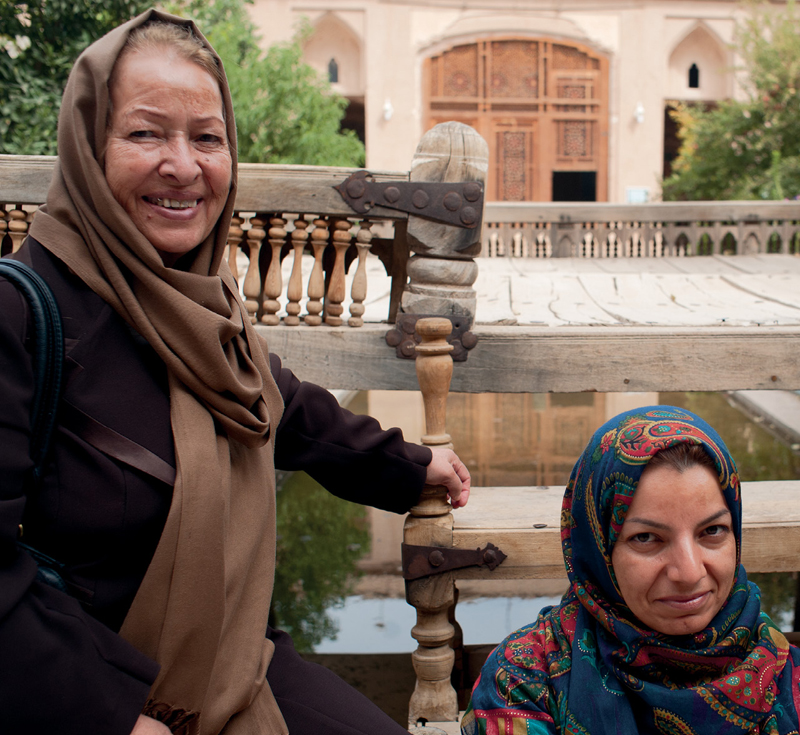
Yazd, Iran—I met these women in a public garden. They were tourists from other parts of Iran. Like many educated Iranians, they spoke good English, which was a pleasure for me.
After some confusion about my ticket, I rushed out onto the train platform in Kerman just a few minutes before the train was due to leave and climbed aboard at the nearest door. My berth was in a compartment two cars farther up, it turned out, so as the train creaked out of the station, I slowly made my way there, passing compartments full of men and boys, and clusters of men standing in the corridor and looking out the windows. I was a surprise to them, visibly foreign, with my badly arranged head scarf, saying “Excuse me” and giving apologetic smiles as I threaded my way through. A door, another car, this one with women and families still stowing luggage and getting settled, and then at last my compartment. The other five passengers, women, were already there. We were going to be together for about fifteen hours, for this was the overnight train from Kerman, in southern Iran, to Mashad, in northeastern Iran.
I felt shy, and so did they. We smiled at each other in encouragement and they showed me where to put my bag. I learned that my companions were a mother and daughter who were traveling to a cousin’s wedding, and a three-generation group: grandmother, daughter, and granddaughter.
The wedding-goers were both strikingly beautiful, the mother in her mid-forties, I guessed, and the daughter in her mid-twenties. The daughter spoke a little English and understood more. Like many young women I’d seen in Iranian cities, she was wearing narrow Band-Aid strips on her face: one over the bridge of her nose and another across the front of her nose just above her nostrils. This badge of recent plastic surgery seems to be worn with no embarrassment in Iran, and often, with some pride. In the first hour or two of the trip, I saw her checking under the strips, using a hand mirror to see how well her scars were healing, then carefully sticking them back on. Like most young women in Iran, she wore lots of makeup and had beautifully manicured hands.
The three-generation family had a different vibe. The grandmother wore a black chador, and under that she had a head covering. She and her daughter wore no makeup and were dressed for comfort rather than style. Perhaps they came from a more rural or working-class background; I didn’t know enough about the social signals to be able to decipher them. The granddaughter was about eighteen, fresh-faced and shyly intrigued with me. Eventually she tried out some English and I some Persian, and we made friends.
The wedding-goers chatted occasionally, but mostly the daughter was on her cell phone, texting and playing games, trying to make the time pass. Was she looking forward to the wedding? Was she hoping to meet a man? Or did she already have a man whom she’d left behind?
The train moved on north, lumbering across the desert-like landscape of central Iran as the light turned golden with sunset dust-glow before night fell.
The grandmother pulled packages of cookies, nuts, and dried fruit out of her bag and offered them around. Everyone produced containers of cooked rice and other food. I had brought only nuts, dried fruit, and some bread. We offered and shared, accepted and demurred, doing the dance of politeness with each other. The others wanted to know my age, my matrimonial status, where I was from, what my job was. When I told them my husband had left the marriage, we all rolled our eyes together and laughed. “Men!” we were saying to ourselves, each in her own language. And everyone relaxed into the journey.
There was a curtain over the glass in the door, so we could be comfortable, without worrying too much about our head coverings. But men—conductors and tea sellers—came by from time to time, first knocking, then sliding the compartment door open, and each time they did, there’d be a rustling and a reaching, to make sure that head scarves were in place and clothing arranged.
Eventually we settled into our berths, and the lights were out by ten. The train stopped several times in the night, with a screeching of metal and the thump of doors opening and closing. At one of those stops, the mother and daughter wedding-goers slipped away.
When early-morning light came, I wanted to see the countryside, but the blinds would be down until we were all dressed, so I headed down the train in search of tea. The landscape had become hilly and green, and the sky was a deep central Asian blue. Flocks of sheep and goats grazed in the morning light.
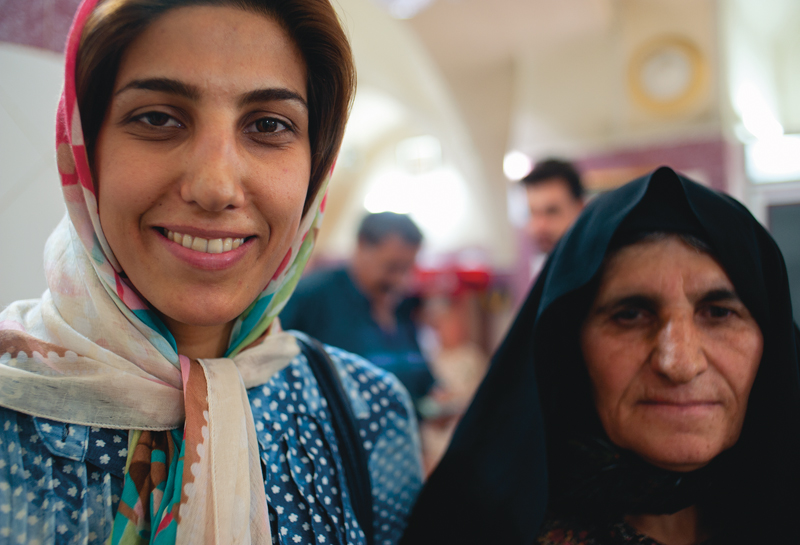
Yazd, Iran—A young woman and her grandmother shopping together in the bazaar. Note her relatively light and pretty head covering, and the contrast with the older woman’s traditional layers of black-on-black topped by a chador.
Halvah is a chameleon, taking on different identities depending on which culture is making it. It’s always a sweet treat and often contains nuts as well as some enriching butter or oil. The word halvah is from the Arabic, and it means sweet. In Arab cultures, halvah is most often made from sesame seeds. But in Persian tradition, it’s made of wheat flour or semolina that is cooked in butter or ghee and sweetened and flavored in various ways, then served in small bites to accompany tea or coffee, or water.
One evening when I was staying in southern Iran, Afsar, my host, and her daughter made this simple halvah. It’s a dense hit of flavor, with sweetness that is not overwhelming and a little crunch from chopped nuts.
Serves 8
¾ cup all-purpose flour
6 tablespoons butter, melted, plus a little more if needed
¾ cup walnuts or pistachios, or a blend, processed to fine crumbs
1 cup pitted dates, finely chopped
Pinch of ground cassia (cinnamon; optional)
About 20 walnut pieces, lightly toasted (optional)
Place a wide cast-iron skillet or heavy pot over medium heat, add the flour, and cook, stirring constantly with a wooden spoon so the flour toasts evenly, without scorching. You’ll soon start to smell the aroma of toasting grain. Keep stirring, and when the flour has changed color slightly, add the butter and stir it into the flour. Lower the heat. Add the ground nuts and mix in. Add the chopped dates. Use the spoon to smear and smooth them, blending them into the paste. It will take 5 to 10 minutes to get them very smooth and integrated. Add a little more melted butter if necessary to help everything blend. Remove from the heat and taste; there should be no raw flour taste. Let cool slightly.
Lightly oil a large dinner plate or a 9-inch square baking pan. When the halvah is cool enough to handle, transfer it to the plate or pan. Use the back of an oiled spoon or your wet or oiled fingertips to press it out evenly, smoothing the surface. The paste should be about ½ inch thick. Sprinkle on the cassia or press the toasted walnuts on top if you wish. Refrigerate to set to a firm fudge texture, at least 30 minutes, or as long as a day.
Cut the halvah into squares or diamonds to serve.
Diamond-shaped Oasis Baqlava (right) and pale rounds of Cardamom Cookies (left; see recipe).
The oasis city of Yazd in the center of Iran is best known for its Zoroastrian fire temple, its underground water channels and astonishing Water Museum, and its distinctive architecture. But among Iranians, it is also famous for cookies and other sweets. These diamond-shaped cookies are cut from a thin, almond-rich cake baked in a small sheet pan and then drenched in rose water syrup. They’re very attractive, and very delicious. This is an adaptation of a recipe I was given by Jennifer Klinec, author of The Temporary Bride: A Memoir of Love and Food in Iran; it comes from her mother-in-law, who lives in Yazd.
Serve the cookies with tea or coffee, or with a tart iced sharbat, made with either bitter orange (see recipe) or tamarind (see recipe).
¼ teaspoon saffron threads
1 cup sugar
⅓ cup water
2 teaspoons honey
¼ cup rose water
About ¼ cup ground pistachios
6 tablespoons unsalted butter, at room temperature
½ cup sugar
3 large eggs
¼ cup rose water
¼ teaspoon ground cardamom
1 cup all-purpose flour
1 teaspoon baking powder
1 cup ground almonds
Place the saffron threads in a small bowl, add 1 tablespoon hot water, stir, and set aside for 30 minutes.
Place a rack in the center of the oven and preheat the oven to 340°F. Line a quarter sheet pan or a 9-by-13-inch baking pan with parchment paper, or use a nonstick pan. (If you have only a large baking sheet, you can use that; the dough holds its shape.)
To make the cookies, use a mixer, or a large bowl and a wooden spoon, to blend the butter and sugar together until smooth. Beat in the eggs one by one. Beat in the rose water and cardamom.
Mix the flour and baking powder together in a bowl and sift into the butter mixture, stirring and mixing as you do so. Add the ground almonds and beat until well mixed.
Scrape the batter into the sheet pan and smooth the top. (If using a large baking sheet, spread the batter out to a 9-by-13-inch rectangle.) Bake for 35 to 40 minutes, until firm to the touch and golden on top. Set aside to cool completely.
Meanwhile, make the syrup: In a small saucepan, combine the sugar with the ⅓ cup water and the saffron water, stir well, and bring to a boil over medium heat, stirring occasionally. Cook at a medium boil for 5 minutes, or until the syrup has started to thicken. Remove from the heat, stir in the honey and rose water, and set aside.
Cut the cooled cake, in the pan, into diamond shapes about 1½ inches long. Pour over the syrup and set aside to soak for 10 to 15 minutes.
Sprinkle on the ground pistachios before removing the cookies from the pan.
Photograph here
These classic cookies from the Persian tradition, made with rice flour, egg yolk, sugar, and butter, are a rather special version of shortbread cookies. More tender than cookies made with wheat flour, they melt in your mouth. They are also a little more brittle and require careful handling once baked.
The classic version is made with white rice flour and topped with chopped pistachios. I use brown rice flour, because it gives a more melting texture to the cookies, and I top each cookie with pine nuts instead of pistachios.
Makes about 40 cookies
½ pound (2 sticks) unsalted butter, melted and cooled to tepid
1 cup confectioners’ (icing) sugar
1 large egg yolk
¾ teaspoon ground cardamom
2 cups brown or white rice flour (see headnote)
Pinch of sea salt
About 3 tablespoons pine nuts
Place the butter and sugar in a medium bowl and stir or whisk together until smooth and pale. Stir in the egg yolk and cardamom. Add 1½ cups of the flour and the salt and mix in thoroughly. Add the remaining ½ cup flour and stir and fold until completely mixed in. The dough will be stiff and pasty.
Transfer to a plastic bag and seal well, or wrap in plastic wrap. Refrigerate for at least 2 hours, or as long as 24 hours.
Place racks just above and just below the center of the oven and preheat the oven to 350°F. Line two baking sheets with parchment paper, leaving an overhang over the short ends. (This makes it easier to lift the paper and cookies off the sheet after baking.)
Cut the cookie dough into 4 pieces, and place 2 back in the refrigerator while you work with the others. Cut off or pull off a generous teaspoon of dough and roll it into a ball with your hands. Place it on one of the lined baking sheets and flatten slightly; don’t worry about perfect shaping, since the cookies will spread as they bake. Repeat with the remaining dough, leaving 1 inch between the cookies.
Once you have filled one sheet, top each cookie with several pine nuts, place on the upper oven rack, and bake for 17 to 20 minutes, or until the edges of the cookies start to turn golden.
Meanwhile, shape the remaining dough and place the baking sheet on the lower oven rack. Switch it to the upper rack once the first sheet of cookies has baked.
The cookies are very fragile when they come out of the oven. Carefully transfer the parchment paper, with the cookies on it, to a rack so they can cool and firm up. After about 20 minutes, they can be lifted off the paper and transferred to a plate or to an open cookie tin to cool completely—or grabbed and eaten right away.
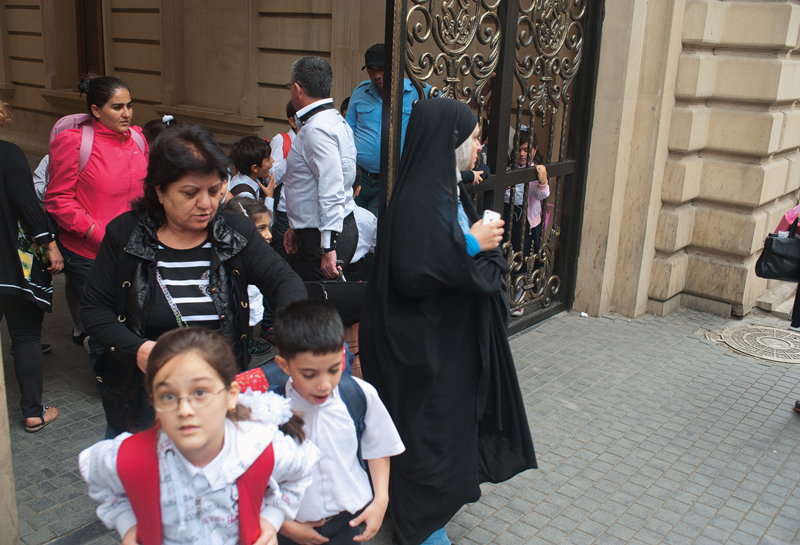
Baku, Azerbaijan—Children getting out of school at lunchtime.
These aromatic cookies are one of the classic seven sweetmeats that are included on the table during Nou-Roz, the Persian New Year. Seven is an auspicious number, and so at Nou-Roz there are seven good-luck foods, the haft-sein.
The cookies, which are about ¾ inch thick and about 1 inch across, have a sandy texture and a subtly enticing rose-water and cardamom flavor.
The main ingredient is roasted chickpea flour. If you can find only unroasted chickpea flour, you’ll need to briefly dry-roast it before making the cookies (see Note). Because the dough must be very smooth and fine-textured, the flour is then triple-sifted before being combined with the oil, sugar, and aromatics.
Makes about 30 cookies
1½ cups superfine sugar (see Note on Sugar)
1½ cups sunflower oil
2 teaspoons ground cardamom
2 teaspoons rose water
4 cups roasted chickpea flour (see Note on Roasting Chickpea Flour), triple-sifted, plus extra for surfaces
About ¼ cup slivered pistachios
Sift the sugar into a medium bowl. Add the oil, cardamom, and rose water and stir for about 2 minutes, until very smooth. Add the chickpea flour and stir and turn until the flour is completely incorporated. Use your hands to fold the dough on itself several times to make sure it is fully blended.
Lightly dust your work surface with chickpea flour and turn out the dough. Pull it together into a lump and flatten it into a smooth disk about ¾ inch thick. Cut the disk in half. Wrap each piece in plastic and refrigerate for at least 1 hour, or for as long as a day.
Place a rack in the center of your oven and preheat the oven to 300°F. Line a baking sheet with parchment paper.
These cookies are usually made in the shape of a clover leaf, but you can use any small cookie cutter (1 to 1¼ inches across). I find the clover-leaf shape a little finicky to work with, so I cut out round cookies. Place one piece of chilled dough on a work surface lightly dusted with chickpea flour and cut out cookies. Use a spatula to transfer them to the baking sheet, leaving ¾ inch between the cookies. Gather the dough scraps, pat into a ¾-inch-thick piece, and cut out a few more cookies. Repeat with the second piece of dough.
Sprinkle a few pistachio slivers on each cookie, pressing very slightly so they stick. Bake for about 25 minutes; the underside of the cookies should be touched with pale brown. Let the cookies stand on the baking sheet for about 10 minutes before moving them, because they are very crumbly when they first come out of the oven. Then use a spatula to transfer them to a fine-mesh rack to cool completely.
Note on Sugar: Granulated sugar is too coarse for these cookies, so look for sugar labeled “fine granulated,” “superfine,” “castor,” or “quick-dissolving.”
Note on Roasting Chickpea Flour: Set a wide cast-iron or other heavy skillet over medium heat. Add the flour and turn and stir it with a spatula as it heats, making sure to scrape the bottom to prevent the flour from burning. Once it is aromatic and starting to get a hint of color, in about 5 minutes, remove from the heat and continue to stir and turn for another couple of minutes to prevent scorching. Transfer to a bowl and let cool before using (you can speed up the process by spreading the flour out on a baking sheet).
Note on Shaping by Hand: Although the cookies are traditionally made as described above, from a firm chilled dough that is cut out into shapes, I often like to make a slightly softer dough and shape the cookies by hand. They’re less uniform, less perfect looking. (They would not meet with approval from a Persian mother-in-law, I imagine.) I use about ¼ cup less chickpea flour and mix and chill the dough as above. To shape, I cut off small pieces of dough, about 1 tablespoon each, and roll them between my palms into balls (about 1 inch in diameter). Then I place them on the parchment paper and press down a little to flatten them slightly; I press on the pistachio shards at the same time. They take the same amount of time to bake into sometimes-irregular rounds.
Black tea in a glass, with a bowl of rough-cut sugar cubes alongside, is the go-to beverage in Iran. Tea has been grown near the Caspian Sea, in the northern province of Gilan, for more than a hundred years. (Before that, it was imported from India and China.) The best Iranian tea is aromatic and memorable.
Until about 150 years ago, coffee held sway in Iran. But now tea rules, though coffee is making a comeback in Tehran. Teahouses (chaikana) are places to meet friends, conduct business, and take pleasure in the day while lounging on wide benches (called takht) covered with carpets. Men, families, and, nowadays, groups of women chat and take their ease, as Persians have done for centuries (see Fountains and Gardens, Picnics and Poetry).
Tea is part of breakfast (to wash down barbari bread; see Village Breakfast) and is drunk as part of business, to welcome guests, or as a pause in the day. Even “ordinary” tea at a café or on the train is a special drink. It may be made in a samovar and poured from it, or instead the samovar may be filled with boiling water that is poured onto the tea leaves in your glass. The glass often has a saucer under it. But that’s all there is: a glass of tea, perhaps a saucer, and a bowl of lump or rock sugar. What’s missing, for people from elsewhere, is a small spoon. And therein lies a tale or two.
In Iran people take sugar with their tea, not in their tea. Some hold a sugar cube in their teeth and sip the tea through it. Some just pop a sugar cube into their mouth and drink the tea while chewing on the sugar. Sometimes tea is served with a stick of sugar crystals or rock sugar, called nabat in Persian, that you can dip in your tea or just suck on as a sweet (see photo). In Yazd, I watched a sugar maker cooking sugar in a huge vat that would eventually be transformed into nabat, a long, hot process.
Occasionally an older person in Iran will dip a sugar cube into the tea and then take a bite of it. This is the story I was told to explain the practice: Sometime long ago (in the late 1800s, it seems), there was a dispute between the authorities and some of the foreign (mostly English) sugar merchants about pricing. The authorities wanted the price to stay down, the merchants wanted a higher price. The authorities played hardball by having the mullahs at the mosques declare that sugar was haram, or unclean. Suddenly no one would buy sugar. This forced the merchants back to the negotiating table and eventually a deal was reached. But how to change the decree about sugar being haram? Simple: The mullahs declared that dipping sugar into tea made it clean.
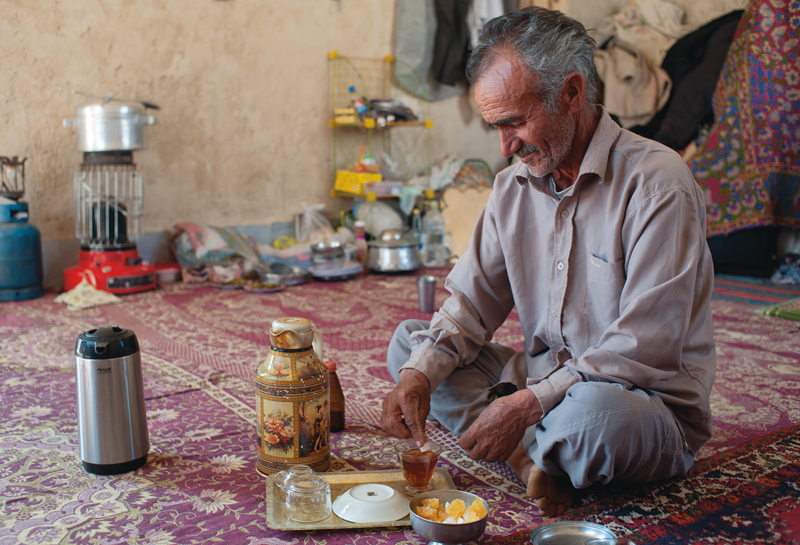
East of Shiraz, Iran—Hajji Hossein, the patriarch of a large nomad family (see Nomad Encounter), dips a cube of sugar into his tea before taking a first sip.
After our excursion to the seashore (see Caspian Interlude), Farahnoz made us tea back at the house from green tea leaves that had been grown nearby. She perfumed it lightly with cardamom. Here’s my approximation of that warming afternoon drink.
Serves 4
About 5 cups water
4 cardamom pods
2 tablespoons green tea leaves
Lumps of sugar for serving
Bring the water to a vigorous boil in a teakettle. Pour a little into a teapot to warm it, and let the kettle stand for a minute to cool slightly.
Crack the cardamom pods with the side of a knife or in a mortar. Pour off the water in the teapot and add the cardamom pods and tea leaves, then add the hot water and stir. Cover and let steep for 5 minutes.
Pour into glasses or small cups. Serve with lumps of sugar.
At a farm homestay near Shiraz, I was offered a glass of tea that was aromatic with a blend of cassia, powdered ginger, and black pepper, and a wonderful welcome.
You can make up a small amount of the spice powder (an advieh, in Persian) any time you’re making tea, but it’s easier to keep a jar of it on hand. Add ½ teaspoon powder to your glass or cup before you pour in the tea. Stir and let stand a moment to allow the flavors to blend. A little sugar will bring the aromas of the spices forward.
Makes about 2 tablespoons; enough for 12 cups of tea
1 tablespoon ground cassia (cinnamon)
2 teaspoons ground ginger
½ to 1 teaspoon freshly ground black pepper
Mix the spices together in a small dry jar. Store in a cool place, out of the sun.
That’s what I wrote in a message to a friend while I was in Iran. But appearances can be deceptive. As far as the nonreligious members of the population are concerned, the ban on alcoholic drinks in Iran is there to be ignored. And that’s a lot of people, I learned, mostly educated and more prosperous people.
“Have you tasted arak?” I was asked one day by a couple of young Iranian men. “No,” I said, surprised. “I thought the whole country was dry.” They laughed. “No, no, you can get anything here. You just have to know where to go. In the countryside, many people make their own wine and spirits. In Tehran, there’s a number you can call and they’ll deliver beer right to your apartment. It even comes chilled!”
The arak they gave me to taste (they’d made a quick trip down the street to buy it from their local “supplier”) was a clear liquor, very alcoholic, that came in a recycled two-liter soft-drink bottle. They drank it straight, over ice. After a first sip, I diluted mine with sour cherry juice and water. Whew!
And I forgot to ask them for the phone number of the beer delivery people. . . .
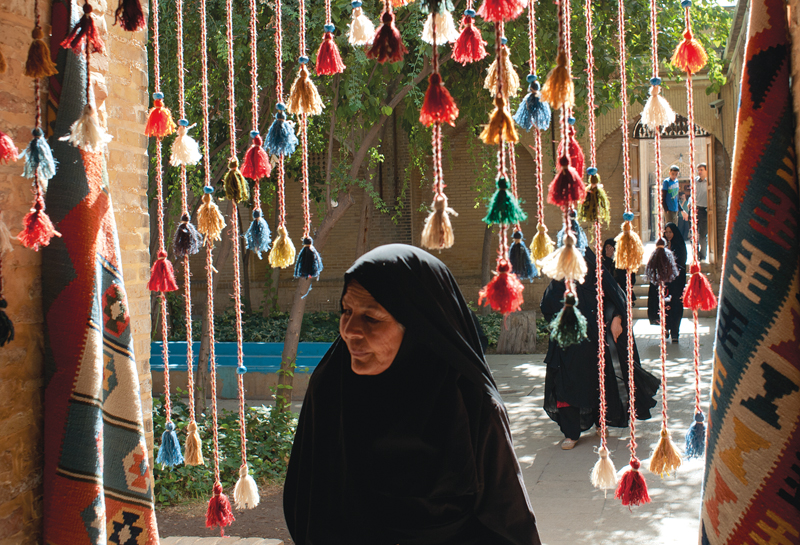
Shiraz, Iran—A woman coming through a shop entrance near the bazaar.

Glasses of coffee with two slices of Armenian Puff Pastry Cake (see recipe).
An ongoing frustration for Armenians and people of Armenian descent is the way that the coffee they know as “Armenian coffee” is generally referred to as “Turkish coffee” by others. Given the painful history of Armenians with Turkey, it adds insult to injury. Coffee made this way is the standard in Armenian households, and is addictive. It is always served black, and always sweetened— a little or a lot, as you wish.
To make it well, you really need to learn in the kitchen of a person who makes terrific Armenian coffee. Second-best is to watch a video on the Internet.
You will need an Armenian coffeepot, a small metal pot with no lid and with a handle on one side, that can hold enough water to make two small cups of coffee. You can find one in an eastern Mediterranean shop or a specialty store. And the coffee must be very finely ground, to a powder. Espresso is not a substitute. You’ll need a little sugar too.
Makes 2 cups
2 heaping teaspoons fine-ground coffee beans
1 to 3 teaspoons sugar
2 cups cold water
Stir the coffee and sugar into the cold water in an Armenian coffeepot and place the pot over the heat. As it heats, the coffee will start to foam. Keep an eye on the rising foam as the coffee comes to a boil, and lift the pot off the heat before it spills over. Place back on the heat, let the foam rise again, and remove from the heat. Repeat a third time. Pour the coffee into two small cups, adding a little to each in turn, then adding a little more.
Serve immediately. When you get close to the bottom of your cup, where there is sludge, stop drinking. Coffee grounds, like tea leaves, have long been used to read fortunes. To read yours, turn the cup upside down on a saucer; most of the coffee sludge will fall onto the saucer. Turn the cup back over and read the patterns in the cup.
Note: At a café in Kurdistan, I had Armenian coffee that had been perfumed with a little cardamom. To do this, add about ⅛ teaspoon ground cardamom or 1 crushed cardamom pod per cup to the cold-water mixture.
West of Baku, Azerbaijan—This beekeeper lives in a small cabin with a great view in three directions and a ginger cat to keep him company.
I can’t talk about sweetness in the Persian culinary region without including a note about honey. The valleys of Georgia are home to a special species of honey bees, Apis mellifera caucasia. They are also found in the valleys of Armenia, Azerbaijan, and eastern Turkey.
When I was traveling with friends in Kakheti, the fertile wine area in eastern Georgia, we came upon a group of beekeepers. Their hives were stacked high on the back of a huge tractor-trailer. The beekeepers park the truck near fields in bloom for a week at a time before moving on in search of new “pastures” for the bees. As the beekeepers checked some of the supers (the wooden boxes that are stacked in layers and that hold the honeycomb), moving carefully and deliberately, never rushing, we chatted with them quietly, so as not to disturb the bees. The men were happy that the sun was out and the weather warming after five or six cool rainy days. The warmth and sun made the bees livelier. We watched as they winged out to the flowering fields to get to work.
A couple of years later, I came upon a beekeeper in Azerbaijan, about an hour’s drive out of Baku. His hives were set out in a hilltop meadow by a small wood. He seemed to be living all alone out there in that lovely lonely place, with big views, and only his cat for company.

Beehives at Ikalto Monastery, in eastern Georgia.
Yogurt is an important food throughout the Persian culinary region: It’s an essential ingredient in Persian borani (see recipes here and here) and in yogurt soups (see recipes here and here), and it’s also the base for a cooling drink with a long history. In Armenian, the drink is known as than; in Azeri, it’s ayran or dugh. In some Kurdish languages, it’s matsoh, while in others it’s dughas; in Georgia, it’s matsoni, and in Persian it’s called dugh (sometimes transcribed doogh).
These days yogurt drinks are sold in plastic bottles, in many different versions, all over the region. Sometimes they’re fizzy, with fermentation or with soda water, and sometimes smooth and flat.
Many people still make dugh at home. Plain full-fat yogurt is diluted with water or soda water and chilled with fragments of smashed ice. It often has a little dried mint added and/or a little toasted ground cumin. Some people include black pepper in their dugh. In the Encyclopedia Iranica, I came across a mention of a special version prized by mystics that includes an extract of hashish and is called dugh-e wahdat in Persian. A similar drink, called bangab (literally, bang-water), is made by adding an infusion of cannabis leaves steeped in water or milk. I have never been offered either one.
Serves 6
4 cups plain full-fat yogurt, chilled
3 cups cold tap water or soda water, or a mixture
½ teaspoon sea salt
1 cup chipped ice
2 teaspoons dried mint (optional)
1 teaspoon cumin seeds, lightly toasted and finely ground (optional)
Mix the yogurt, water, and salt in a pitcher and stir thoroughly to blend them. (Or use a blender.) Add the chipped ice just before serving. Sprinkle on or stir in the mint and/or cumin, if using. Serve in tall glasses.

Halabja, Kurdistan—A small shop specializing in yogurt, yogurt drinks, butter, and fresh cheese.